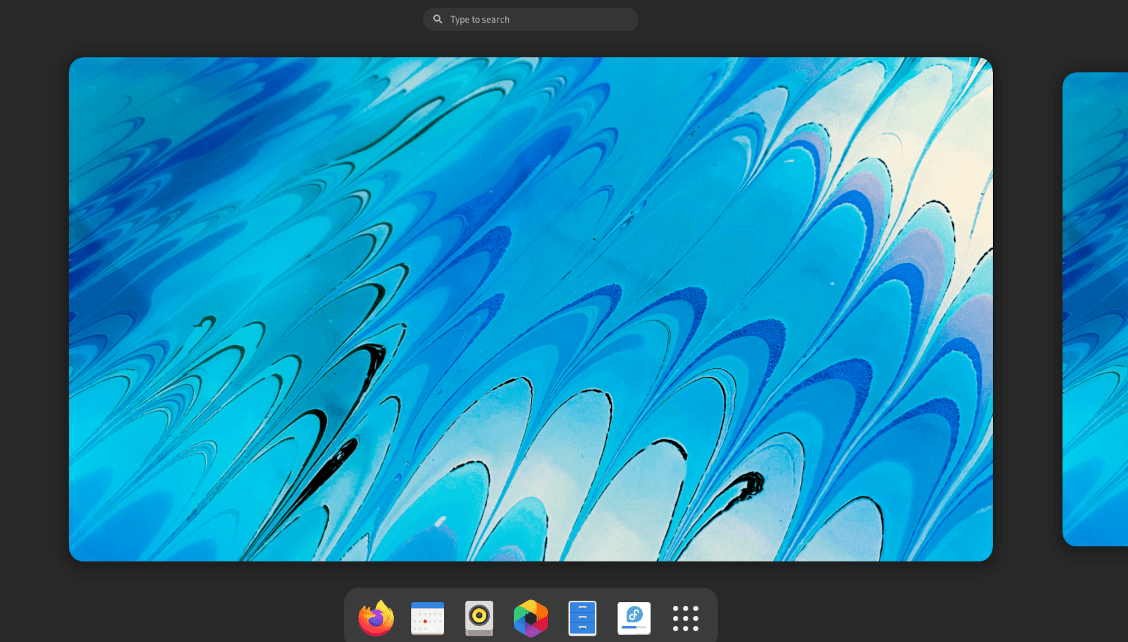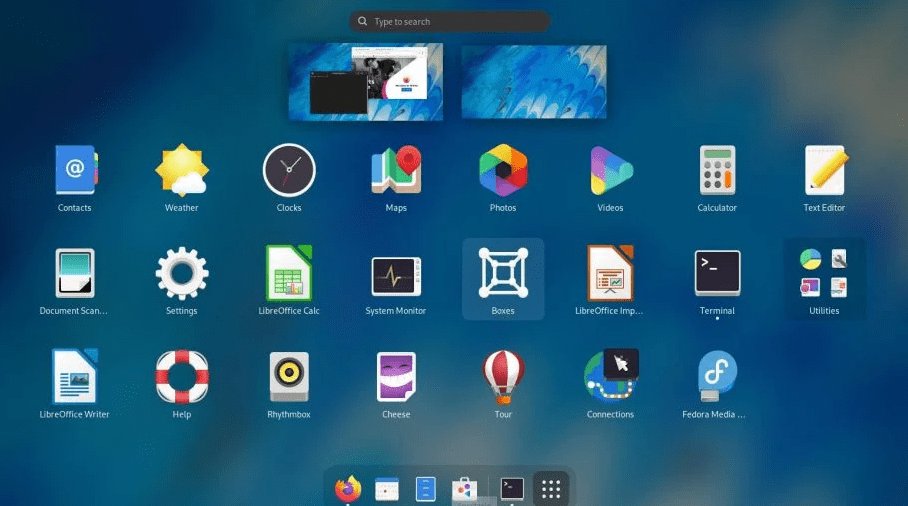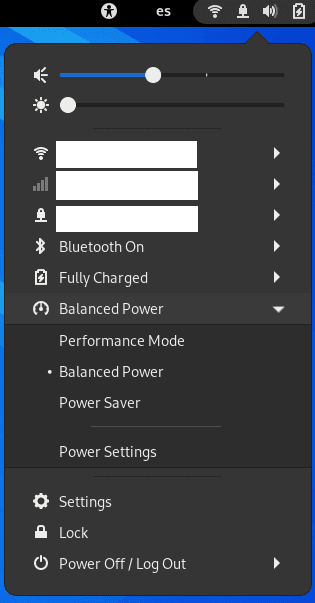Finally, the wait for the official release of Fedora Workstation 35 is over! The official stable release was made available for download after being pushed back to resolve some outstanding bugs.
The wait was definitely worth it! True to Fedora foundations of “First” & “Features,” the release includes the new GNOME 41, updated developer tools, new programming languages, new power management profiles, parental controls, and improvements in the management of other third-party apps. The release cycle also includes Fedora Kinoite, a new edition based on Fedora Silverblue’s OSTree technologies. In addition, the edition features the KDE Plasma desktop.
This article is a description of the new features and improvements in Fedora Linux 35.
Polished Fedora Linux 35

Fedora Linux 35
Fedora Linux 35 is all about the polish. True to its four foundations of “Freedom,” “Features,” “First,” & “Friends,” Fedora 35 focuses on extending existing features, refinements, and improved support. The Fedora community seeks to create a desktop PC with bleeding-edge technologies to level up the experience of using Fedora Linux. Whether you use Fedora as a Workstation, a cloud-based image, or a Linux container image, you’ll find improvements that make Fedora 35 a nice upgrade.
You can get Fedora Workstation 35 from the official website. You can also upgrade your existing Fedora through the terminal with dnf system-upgrade or using GNOME Software.
Linux Kernel 5.14
The new Linux 5.14 kernel has found its way into Fedora 35. It has brought many ARM-specific improvements primarily related to GPUs (support on AMD Radeon graphics cards). It also features improved support for USB 4.
Desktop environments
GNOME 41

Fedora GNOME 41 Desktop
Fedora 35 Workstation now ships with GNOME 41. It brings new changes like improved multitasking, a Mobile network connections Settings panel, a new remote desktop client (Connections app). Its redesigned and improved software center makes it easier to browse and discover applications. And that’s not all GNOME 41 also includes touchpad gestures, power profiles, and other performance enhancements.
Additionally, the horizontal workflow introduced in GNOME 40 (shipped in Fedora 34) features new design enhancements to improve user experience.
Redesigned Software app
GNOME 41 includes an improved redesign of the Software app, featuring a clean user interface. You can now easily find apps through the updated Explore page and app categories. It also includes more screenshots and information about the app.

GNOME 41 Software
Support for new power profiles
Fedora Workstation 35 features improvements in power profiles that are active by default. We were first introduced to power modes in GNOME 40 and are available in Fedora 34 by installing power-profiles-daemon.

GNOME 41 Power Profiles
GNOME 41 gives you the option to choose between “Balanced,” “Power saver,” and “Performance” modes. The “Balanced” power profile is the default standard power mode. “Power Saver” mode will use less energy at the cost of system performance. “Performance” mode can boost your computer’s performance but only on supported hardware. Note that “Performance mode” uses more energy.
You can easily change to the desired power profile from the Power section of the Settings app or the system status menu in the top bar.
New Connection app
GNOME 41 features the Connections app to manage remote desktop connections over RDP and VNC. This functionality was part of the Boxes app in previous Fedora releases.
Parental controls
GNOME’s Parental Controls functionality now ships with Fedora Workstation 35. It allows you to block standard users from installing new applications or using applications you do not want them to use. You can access Parental Controls from the Users panel in System Settings.
Music
The Music app comes with new UI updates for GNOME 41. It features larger artwork and new welcome artwork. The artist list includes images, while a new album view features a handy play button with a more spacious player bar. If you are a music lover (who isn’t), you will fancy trying out these improved Music features.

GNOME 41 Music
Other notable improvements in GNOME 41
- Introduction of Multitasking panel settings for app switching and workspaces.
- It features a new Mobile Network panel to access and configure cellular network modem settings quickly.
- You can now create encrypted, password-protected .zip files from within the Files app.
- You can import events from .ics files in Calendar.
- Improved support for dark mode for web, faster pinch to zoom, and enhanced handling of unresponsive websites.
- It implements better window resizing in Calculator that will now reveal additional controls.
Other desktop environments
KDE Plasma 5.22
Understandably, this Fedora 35 release doesn’t include the recently released Plasma 5.23, instead opting for Plasma 5.22. KDE Plasma 5.22 implements the adaptive transparency feature with improved Krunner and system settings. You can explore more about KDE Plasma 5.22 or KDE Plasma 5.23.
Apart from GNOME and KDE Plasma 5.22, Fedora 35 maintains similar versions of other desktop environments released with Fedora 34. If you use another desktop version, you get the following desktops.
- GNOME 41
- KDE Plasma 5.22
- Xfce 4.16
- LXQT 0.17
- MATE 1.24
FUN FACT:
You have to be at least 35 years old to be President or Vice President of the United States.
Improved support for third-party application and software repositories
The redesigned Software store includes improved support for Flatpak containers. In addition, Fedora 35 contains a new set of applications from Flathub in the third-party repositories. However, you have to enable them after you install Fedora 35. The apps are provided by a Flathub remote curated by Fedora Project contributors. Select apps include Bitwarden, Discord, Postman, Microsoft Teams, Skype, Zoom, and Minecraft.
I bet you the Fedora team will expand the list. I expect to see more Flatpaks in future releases. Moreover, you can get a complete set of Flathub apps by adding the Flathub remote.
Note that Flatpak applications run in containers that are separate from your system. Containers increase security since the apps don’t have unfettered access to the entire system.
You can, of course, also still install programs with RPM.
Pipe Wire
PipeWire made its introduction in Fedora Workstation 34 as the default audio and video server for Fedora releases. It was a significant addition to Fedora 34, and it continues to mature with new releases. PipeWire in Fedora 35 features improved Bluetooth handling, bug fixes, support for pass-through of S/PDIF signals over optical and HDMI connections.
WirePlumber also makes an introduction as the new and advanced session manager to replace PipeWire Media Session. WirePlumber is more advanced with support for plugins and scripting with Lua.
Improvements on Wayland on Nvidia
Nvidia’s proprietary driver now includes massively enhanced support for Wayland, thanks to tight collaboration between the Red Hat, Nvidia teams, and Fedora. It enables users to run applications that don’t have native Wayland support to benefit from 3D support under NVIDIA drivers.
Moreover, libinput in Fedora 35 now includes support for high-resolution scrolling with mouse wheels.
System-wide changes
As custom in any Fedora release cycle, all Fedora editions and spins use a common base with updates on the Linux kernel, system libraries, developer tools, and much more. Some notable system-wide changes include the following:
- Adoption of a policy change allows packagers to make a technical case for using GCC or Clang/LLVM to build their packages
- GNU Toolchain update
- Firewalld 1.0 package update
DNS over TLS (DoT) support
Privacy is a critical aspect in this day and age. The Fedora project team has introduced support for DNS over TLS (DoT). This technology will attempt to send DNS requests over TLS. If you’ve chosen custom DNS servers that offer encryption, you can enjoy additional protection from passive network attacks.
In essence, this means that your ISP shouldn’t be able to spy on your browsing history or activities, which is a welcome for all.
Developer tools
As with every Fedora release cycle, developers get new programming languages and system library updates. The underlying packages and toolchain and get updates with the latest stable version.
Python 3.10 Node.js 16.x Perl 5.34 PHP 8.0 Binutils 2.36 gcc 11 glibc 2.34 RPM 4.17 binutils 2.37 gdb 10.2 LLVM 13
Gaming in Fedora 35
For gamers out there (guilty as charged), Fedora 35 packages a few exciting games like Inertia Blast, Anagramarama, and Alchemy Quest.
- Inertia Blast – a clone of the 1986 video game Thrust
- Anagramarama – a word game that challenges you to make as many anagrams as possible
- Alchemy Quest – a Tetris-esque game
These games are worth a try for any gamer.
Fedora Server family
Fedora cloud
A notable improvement in Fedora 35 Cloud images is the introduction of hybrid BIOS+UEFI boot support. In essence, if UEFI doesn’t work, you still have legacy BIOS support as a fallback.
Btrfs is now the default file system for Fedora Cloud. Btrfs was introduced as the default file system in Fedora Workstation 34 and will see increased adoption in the Fedora family. You can take advantage of transparent compression to save filesystem space or other features of Btrfs.
Fedora Kinoite: A new Fedora KDE edition

Fedora Kinoite
Fedora Kinoite is the newest kid in the block. Fedora Linux 35 introduces Fedora Kinoite, a new edition based on Fedora Silverblue’s underlying technologies (Fedora Linux, Podman, RPM OSTree). It features KDE Plasma desktop by default, instead of GNOME.
Fedora project team describes Fedora kinoite as a next-generation operating system. It lets you manage everyday work, surf the web, manage files, and get productive without worrying about breaking your system.
Learn more about the project from Fedora Kinoite official home page or Download either the X86_64 or AArch64 architecture and give it a spin.
Get the complete list of changes from the official changelist or the official Fedora 35 announcement.
Wrapping up
Fedora Linux 35 is all about the polish and smoothing of a few rough edges from Fedora 34. This release focuses majorly on improvements to the Fedora Linux system. And true to its philosophy of “First,” the Fedora project team introduces all the latest packages, GNOME 41, and server technologies. You will notice improvements to your system with the introduction of Linux Kernel 5.14 and GNOME 41.
As you’d expect with any latest Fedora release, it comes, by default, with the latest versions of LibreOffice, Firefox, and other preinstalled apps to get started with your new operating system.
I should give Fedora Kinoite [the new kid on the block] a spin to get its feel and take advantage of some Flatpak applications and Podman containers.
Freedom, First, Friends, Features.
Happy with Fedora.


1 comment
Very interesting, we need article like this, very useful, thank you